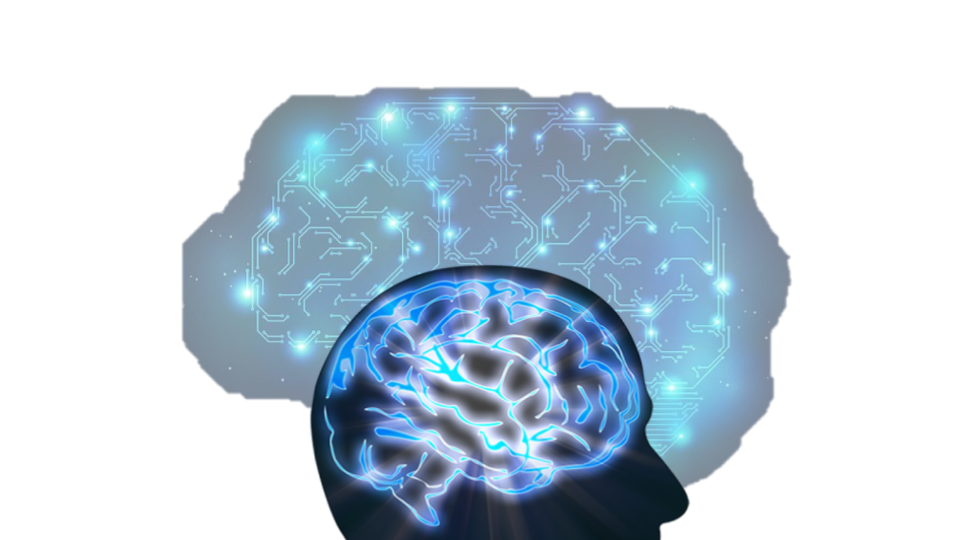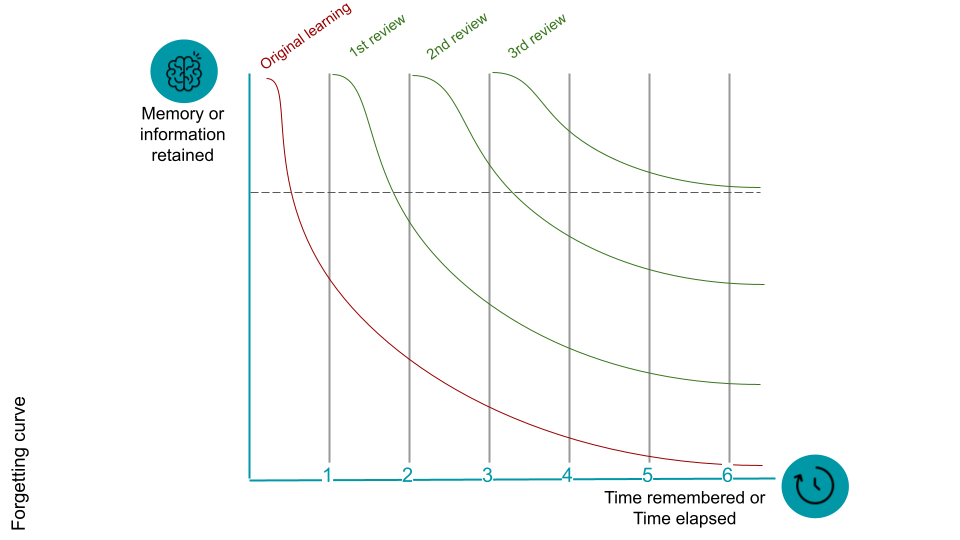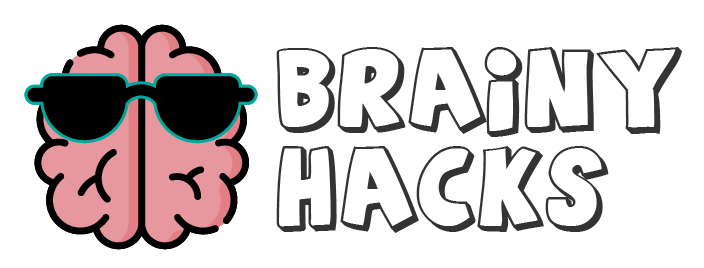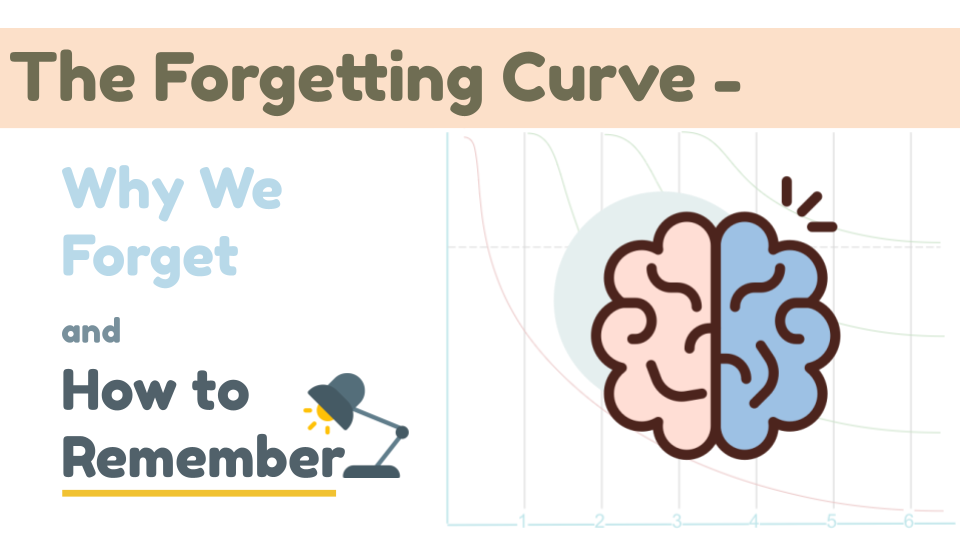Have you ever wondered why some memories stick with you while others slip away into oblivion? This is not down to chance, but a phenomenon called the forgetting curve.
Why do we forget things?
Like a computer, our brain can gain tons of information, but unfortunately, unlike a computer, our brain tends to forget. Forgetting is a frustrating side of our memory. While our brain may constantly receive new information, we cannot rely on retrieving them all indefinitely. This is because the brain is an organic, biological organ that makes neural connections whenever information is learned. It requires energy and physical changes to create and maintain these connections. Think of it like a roadmap. There are highways and main roads where information is regularly accessed and used. Then there are smaller and smaller minor roads until you’re literally in a back alley. Compared to a main road with its neatly manicured curbs, smooth road surface, and well-maintained signs, it’s not every day that you wander down a back alley, which will be dark and dirty. And so this information is likely to disappear due to a lack of maintenance and “visits”. This is where the forgetting curve demonstrates the phenomenon of being unable to retrieve pieces of information.

While learning new things is fun. Forgetting a lesson for an exam, the grocery list for the next day, or the direction of going to a new place is not as fun. Forgetting is the apparent loss of the information acquired in a person’s long or short-term memory (Maddox, Balota, Coane, & Duchek, 2018). This natural course of forgetting information we learned was first extensively studied by 19th-century German psychologist and pioneer of experimental psychology Herman Ebbinghaus in his forgetting curve.
Other than pioneering the learning curve, Ebbinghaus’ fascination with memory was further explored in his 1885 book, Über das Gedächtnis (later translated into English as Memory: A Contribution to Experimental Psychology), which states that memories can be lost over time, but can be reinforced in different ways. His personal study, involving the memorization of nonsense syllables, resulted in a memory model, the Forgetting Curve.

Illustration originally made for Brainyhacks
Ebbinghaus’ forgetting curve has memory or the information retained from learning, and time elapsed (in days) variables. His experiment revealed significant aspects of memory, including:
- Memories + time – efforts = forgetting. Memories or the information we learn, like the formula for the circumference of a circle or the steps in doing a science experiment, are likely to be forgotten when no efforts to relearn are made because memories weaken hours, days, and weeks upon learning. As a matter of fact, learners tend to forget about 90% of a material within a month (Woolliscroft, 2020).
- Making meaning. Ebbinghaus hypothesize that the more the information has meaning to the learner, the more it would be retained and less likely to be forgotten. For example, the retention level between a student who’s into art history is more likely to enjoy and retain memories from museum visits than a student who likes developing software. Ebbinghaus’ nonsense syllables are easier to forget, rather than learning information which is presented in a more meaningful and relatable way.
- Physiological factors affect memories. Stress and sleep are two factors that affect our ability to retain information (Ebbinghaus, 1885). A person in constant stressful situations is more likely to forget things. For example, if a student runs late for school for the science fair while preparing for another performance for physical education, she’s more likely to forget a thing or two. Furthermore, Ebbinghaus suggests that proper and complete sleep aids our brains in storing information.
The Road to Retention – Combatting the Forgetting Curve
Knowing such natural functioning of the brain and forgetting the details of significant events, little things that may guide our lives, and even the results of exams sounds crazy, thankfully, Ebbinghaus did not stop in understanding the weaknesses of our memory. In his work, he also identified ways to refrain from forgetting by strengthening our memory.
- Spaced learning. Mahatma Gandhi once said, “An ounce of practice is worth more than tons of preaching.” Like Gandhi, one of Ebbinghaus’ remarkable results is using spaced learning or reviewing what you learned in time intervals. For students, reviewing materials, such as presentations, electronic communication, or testing, enhances retention (Wollingscroft, 2020). For teachers, reinforcement or follow-up activities of the lessons after the lecture is an ideal training to promote retention (Gay & Sutherland, 2016). So getting ready for an End-of-Year test in math must include constant review sessions until the exam date. For more tips on spaced repetition, see our article on The Leitner System for Studying.
- Overlearning. It may sound intense, but overlearning is one of Ebbinghaus’ suggestions to strengthen our memory and fight the forgetting curve. Aside from putting more effort into learning something, using different memory tips and tricks to help our brain remember much of what we learn, including:
- Use of mnemonics to make information memorable. It could be through letters, words, and music. In math, the order of operations PEMDAS (Parenthesis, Exponents, Multiplication and Division, and Addition and Subtraction) can be remembered as “Please Excuse My Dear Aunt Sally”. For higher maths, there’s SOH-CAH-TOA for Sine = Opposite/Hypotenuse, Cosine = Adjacent/Hypotenuse, Tangent = Opposite/Adjacent in trigonometric ratios.
- Speak to yourself or write it out. Talking aloud instead of highlighting important information to memorize works with many people. Others find rewriting what they learned effective. Find where and how you study best.
- Study in intensive sessions. Other than spaced learning, intensive study sessions are among students’ most effectively used teaching-learning strategies (Newport, 2007). Rather than teaching and learning the American Revolution in 2 to 3 days, using short yet multiple intensive study sessions within a month, students are more likely to grasp information. About 30 to 45 minutes can be allotted for each intensive study session about the causes of the revolution, the Declaration of Independence, and the formation of the Constitution. If you need more guidance to apply this tip, read our article on How to Apply the Feynman Learning Technique.
Since Ebbinghaus’ experiment, more and more studies have been conducted that prove that the more we put effort into retrieving the information we learn, the more it will be stored in our long-term memory, thus combating the forgetting curve. Learn more about this in our Retrieval Practice Explained article.
As each of us is unique, so is our approach to learning and remembering. Some may find visual presentations more memorable, while others prefer audiobooks. Discovering your learning style and employing the right techniques can help you successfully retain knowledge and dodge the forgetting curve.
References
- Ebbinghaus, H. (1885). ‘Memory: A contribution to experimental psychology,’ New York: Dover. Translation retrieved from: https://web.archive.org/web/20050504104838/http:/psy.ed.asu.edu/~classics/Ebbinghaus/index.htm
- Gay, S.; Sutherland, S. (2016). Teaching Genetics and Genomics for Social and Lay Professionals. Retrieved from: https://www.sciencedirect.com/topics/agricultural-and-biological-sciences/forgetting-curve
- Maddox, G. B.; Balota, D. A.; Coane, J. H. & Duchek, J. M. (2011). “The role of forgetting rate in producing a benefit of expanded over equal spaced retrieval in young and older adults”.
- Newport, C. (2006). How to become a straight-a student: the unconventional strategies real college students use to score high while studying less. Three Rivers Press. Retrieved from:https://learningcenter.unc.edu/tips-and-tools/studying-101-study-smarter-not-harder/
- Wolliscroft, J. (2020). Considerations when designing educational experiences. Retrieved from: https://www.sciencedirect.com/topics/agricultural-and-biological-sciences/forgetting-curve


1 thought on “The Forgetting Curve”
Comments are closed.